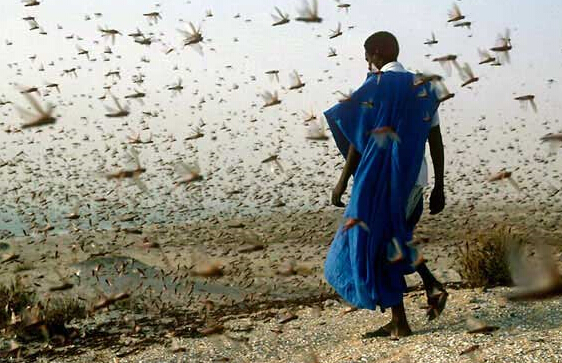托福分数测试HOT
托福课程优惠HOT
托福正价课试听0元
新托福机考练习NEW
0元讲座HOT
新版托福入门课程HOT
托福入门导学NEW
4000人报
托福机经
PDF版
TPO练习
官方授权
资料下载
826套
专业测评
40118人已测
高分经验
1193帖

扫码免费领资料
托福全科备考资料
免费水平测试及规划

扫码关注掌握一手留学资讯
回复XDF免费水平测试
本文是托福听力TPO46 Swarm Intelligence. 相关背景资料 National Geographic。托福阅读材料推荐:群体智能希望对大家托福备考有所帮助。更多精彩尽请关注新东方在线托福网!
Swarm Theory

The Genius of Swarms
A single ant or bee isn't smart, but their colonies are. The study of swarm intelligence is providing insights that can help humans manage complex systems, from truck routing to military robots.
By Peter Miller
National Geographic Staff
Photograph by Jean-François Hellio and Nicolas Van Ingen
I used to think ants knew what they were doing. The ones marching across my kitchen counter looked so confident, I just figured they had a plan, knew where they were going and what needed to be done. How else could ants organize highways, build elaborate nests, stage epic raids, and do all the other things ants do?
Turns out I was wrong. Ants aren't clever little engineers, architects, or warriors after all—at least not as individuals. When it comes to deciding what to do next, most ants don't have a clue. "If you watch an ant try to accomplish something, you'll be impressed by how inept it is," says Deborah M. Gordon, a biologist at Stanford University.
How do we explain, then, the success of Earth's 12,000 or so known ant species? They must have learned something in 140 million years.
"Ants aren't smart," Gordon says. "Ant colonies are." A colony can solve problems unthinkable for individual ants, such as finding the shortest path to the best food source, allocating workers to different tasks, or defending a territory from neighbors. As individuals, ants might be tiny dummies, but as colonies they respond quickly and effectively to their environment. They do it with something called swarm intelligence.
Where this intelligence comes from raises a fundamental question in nature: How do the simple actions of individuals add up to the complex behavior of a group? How do hundreds of honeybees make a critical decision about their hive if many of them disagree? What enables a school of herring to coordinate its movements so precisely it can change direction in a flash, like a single, silvery organism? The collective abilities of such animals—none of which grasps the big picture, but each of which contributes to the group's success—seem miraculous even to the biologists who know them best. Yet during the past few decades, researchers have come up with intriguing insights.
One key to an ant colony, for example, is that no one's in charge. No generals command ant warriors. No managers boss ant workers. The queen plays no role except to lay eggs. Even with half a million ants, a colony functions just fine with no management at all—at least none that we would recognize. It relies instead upon countless interactions between individual ants, each of which is following simple rules of thumb. Scientists describe such a system as self-organizing.
Consider the problem of job allocation. In the Arizona desert where Deborah Gordon studies red harvester ants(Pogonomyrmex barbatus), a colony calculates each morning how many workers to send out foraging for food. The number can change, depending on conditions. Have foragers recently discovered a bonanza of tasty seeds? More ants may be needed to haul the bounty home. Was the nest damaged by a storm last night? Additional maintenance workers may be held back to make repairs. An ant might be a nest worker one day, a trash collector the next. But how does a colony make such adjustments if no one's in charge? Gordon has a theory.
Ants communicate by touch and smell. When one ant bumps into another, it sniffs with its antennae to find out if the other belongs to the same nest and where it has been working. (Ants that work outside the nest smell different from those that stay inside.) Before they leave the nest each day, foragers normally wait for early morning patrollers to return. As patrollers enter the nest, they touch antennae briefly with foragers.
"When a forager has contact with a patroller, it's a stimulus for the forager to go out," Gordon says. "But the forager needs several contacts no more than ten seconds apart before it will go out."

 资料下载
资料下载
2021-2025托福机经试题|答案|范文下载
发布时间:2024-02-21关注新东方在线托福
回复【XDF】获取
托福全科备考资料大礼包
发布时间:2024-02-21关注新东方在线托福
回复【XDF】获取
托福正价课试听课程包
发布时间:2024-02-21关注新东方在线托福
回复【XDF】获取
托福定制备考规划
发布时间:2024-02-21关注新东方在线托福
回复【XDF】获取
托福TPO免费模考
发布时间:2024-02-21关注新东方在线托福
回复【XDF】获取
托福免费水平测试
发布时间:2024-02-21关注新东方在线托福
回复【XDF】获取
托福写作新题型模拟题+范文汇总[ETS发布]
发布时间:2023-07-30关注新东方在线托福
回复【XDF】获取
2023全年托福机经PDF版下载
发布时间:2023-06-17关注新东方在线托福
回复【XDF】获取
2022全年托福机经PDF版下载
发布时间:2023-06-17关注新东方在线托福
回复【XDF】获取
2022全年写作托福机经整理
发布时间:2023-01-13关注新东方在线托福
回复【XDF】获取
2022年托福考后题目回忆
发布时间:2023-01-13关注新东方在线托福
回复【XDF】获取
托福口语黄金80题附录音
发布时间:2023-01-13关注新东方在线托福
回复【XDF】获取
新东方IBT写作网络课堂录音[.rar]
发布时间:2023-01-13关注新东方在线托福
回复【XDF】获取
21天托福听力提升计划
发布时间:2023-01-13关注新东方在线托福
回复【XDF】获取
不怕跑题偏题,这份写作资料请收好
发布时间:2023-01-13关注新东方在线托福
回复【XDF】获取
托福阅读提分技巧锦囊妙计
发布时间:2023-01-13关注新东方在线托福
回复【XDF】获取
口语拖后腿?因为你缺少这套万能句式资料
发布时间:2019-11-01关注新东方在线托福
回复【XDF】获取
攻破托福听力难关的资料包
发布时间:2023-01-13关注新东方在线托福
回复【XDF】获取
看剧学英语,经典美剧一键获取
发布时间:2019-11-01关注新东方在线托福
回复【XDF】获取
原版外刊资源合集|精心打包整理
发布时间:2019-11-01关注新东方在线托福
回复【XDF】获取

关注新东方在线托福,
回复【XDF】获取大礼包

 推荐阅读
推荐阅读
托福考试网整理了2024托福考试时间、托福考试内容、托福写作新题型样题+范文、托福考题等内容,今天带来的是ETS官方托福阅读模拟题【2】,希望对同学们托福考试有所帮助!
托福考试网整理了2024托福考试时间、托福考试内容、托福写作新题型样题+范文、托福考题等内容,今天带来的是ETS官方托福阅读模拟题【1】,希望对同学们托福考试有所帮助!
托福考试网为大家整理了2024年托福阅读评分标准、托福阅读考试时间、托福阅读备考攻略等内容,今天给大家带来的是2024年1月托福考试考前刷题:阅读题(4),供大家参考!
托福考试网为大家整理了2024年托福阅读评分标准、托福阅读考试时间、托福阅读备考攻略等内容,今天给大家带来的是2024年1月托福考试考前刷题:阅读题(3),供大家参考!
托福考试网为大家整理了2024年托福阅读评分标准、托福阅读考试时间、托福阅读备考攻略等内容,今天给大家带来的是2024年1月托福考试考前刷题:阅读题(2),供大家参考!



 资料下载
资料下载
关注新东方在线托福
回复【XDF】获取
关注新东方在线托福
回复【XDF】获取
关注新东方在线托福
回复【XDF】获取
关注新东方在线托福
回复【XDF】获取
关注新东方在线托福
回复【XDF】获取
关注新东方在线托福
回复【XDF】获取
关注新东方在线托福
回复【XDF】获取
关注新东方在线托福
回复【XDF】获取
关注新东方在线托福
回复【XDF】获取
关注新东方在线托福
回复【XDF】获取
关注新东方在线托福
回复【XDF】获取
关注新东方在线托福
回复【XDF】获取
关注新东方在线托福
回复【XDF】获取
关注新东方在线托福
回复【XDF】获取
关注新东方在线托福
回复【XDF】获取
关注新东方在线托福
回复【XDF】获取
关注新东方在线托福
回复【XDF】获取
关注新东方在线托福
回复【XDF】获取
关注新东方在线托福
回复【XDF】获取
关注新东方在线托福
回复【XDF】获取

 阅读排行榜
阅读排行榜
 相关内容
相关内容